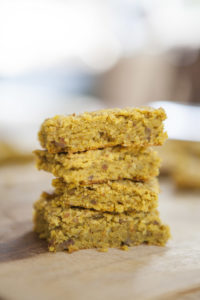 I’ve seen a ton of hype toting the benefits of turmeric and decided to try making some lemon turmeric bars. I was sold on turmeric when I learned that curcumin (an active ingredient in turmeric) may have a “magical” effect when combined with genestein (a phytoestrogen derived from soy) for people with cystic fibrosis. As you know, my daughter has CF, so herbs like turmeric may be especially important for her healthy future.
I’ve seen a ton of hype toting the benefits of turmeric and decided to try making some lemon turmeric bars. I was sold on turmeric when I learned that curcumin (an active ingredient in turmeric) may have a “magical” effect when combined with genestein (a phytoestrogen derived from soy) for people with cystic fibrosis. As you know, my daughter has CF, so herbs like turmeric may be especially important for her healthy future.
Turmeric is a plant of the ginger family whose mildly flavored roots have been traditionally used as an Indian spice (also used in China, Bangladesh, and more recently in Latin America and other tropical islands). But this golden, glowing root has a number of medicinal properties which include the treatment of:
- Gallbladder problems
- Hepatitis
- Indigestion
- Infections
- Lack of appetite
- Alzheimer’s
- Arthritis
- Heart disease
- High cholesterol
- Inflammation
The list goes on. Maybe it would be more appropriate to figure out what this herb doesn’t do. And the great news is that turmeric is extremely safe for the majority of folks. There are a few known drug interactions, so be sure to talk to your doctor if this applies to you. I also found a study in which lab rats were fed turmeric as 10% of their diets, which ultimately caused their hair to fall out. So, just don’t eat a diet that’s 10% turmeric and your hair should be just fine.
 The easiest way to consume turmeric for therapeutic use is in capsules or pills, but I’m experimenting with ways to incorporate it on a more regular basis into our diet. These lemon turmeric bars were the first of many to come turmeric experiments and I think it went fairly well despite the fact that you’d have to eat a ton of these bars to get a therapeutic response such as the one that I’m interested in seeing in my daughter. Depending on your desired response, it is recommended to consume 1/2 – 3 tsp of turmeric/day, which means you’d be eating at least a 1/4 of this recipe in a day. Not impossible, but not likely. But, for the general population, this is a good start to incorporating more turmeric into your diet. I also think it’s a great food to eat even in small amounts while exercising or on the go because of its anti-inflammatory properties.
The easiest way to consume turmeric for therapeutic use is in capsules or pills, but I’m experimenting with ways to incorporate it on a more regular basis into our diet. These lemon turmeric bars were the first of many to come turmeric experiments and I think it went fairly well despite the fact that you’d have to eat a ton of these bars to get a therapeutic response such as the one that I’m interested in seeing in my daughter. Depending on your desired response, it is recommended to consume 1/2 – 3 tsp of turmeric/day, which means you’d be eating at least a 1/4 of this recipe in a day. Not impossible, but not likely. But, for the general population, this is a good start to incorporating more turmeric into your diet. I also think it’s a great food to eat even in small amounts while exercising or on the go because of its anti-inflammatory properties.
Lemon Turmeric Bars
For this recipe, I’ve combined oats, healthy fats from coconut and nuts, and protein from eggs and nuts and a bit of raw vegan pea protein powder. You’ll also notice that I’ve added a small amount of pepper. This is because turmeric isn’t fully absorbed unless eaten with pepper. If you’re buying a supplement, be sure that pepper is also an ingredient otherwise find a different supplement. Turmeric must also be eaten with abundant fat in order to be absorbed, thus the use of so much fat in these bars. And besides that, fat is good despite what we were told in the past. I’ve also added maca, a superfood known to increase energy levels – another reason to eat these while on the go.




- 2 cups whole rolled oats
- 2 cups almonds
- 1 cup unsweetened shredded coconut
- 2 scoops Sunwarrior Raw Vegan Protein Powder Vanilla
- 1 1/2 tbsp maca powder
- 2 tsp turmeric powder
- 1 1/2 tsp sea salt
- 1/8 tsp black pepper
- 1 can full fat unsweetened organic coconut milk
- 1/2 cup honey
- 3 eggs
- zest and juice from 1 lemon
- 1 cup pecans
- Blend oats in food processor to form a flour-like consistency.
- Add almonds and coconut to the oats and blend till a flour forms.
- Add remaining dry ingredients except for the pecans (protein powder, maca, turmeric, sea salt and black pepper) to the mixture and blend to mix.
- Add wet ingredients (coconut milk, honey, eggs and lemon juice and zest) and blend till well mixed.
- Add the pecans to the mixture and pulse till well-combined, but not pulverized. This gives the bars a bit of a crunch.
- Pour and smooth mixture into a parchment paper-lined baking sheet and bake at 350 degrees for 30 minutes. Baking time will vary depending on the size of your baking sheets and the thickness of your bars.
- Allow bars to cool completely before cutting into desired size.
Leave a Reply